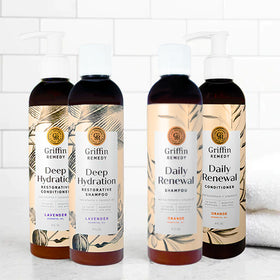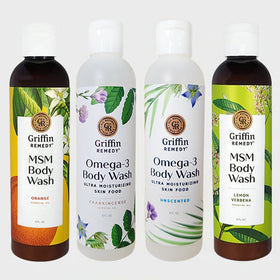
Top 3 Natural Remedies for Dry Skin and Cuticles
Q: Why are my cuticles and skin so dry all the time?
I’ve heard that fish oil can help. Am I deficient in omega fats? What are other nutrient imbalances that cause dry skin? —Leanne W., St. Cloud, Minn.
A: You’re right to think that fats are key. Especially in the winter, a misguided low-fat diet combined with cold temperatures can really stress the skin. And keeping your skin healthy is important. Skin’s thin outer layer is your largest organ of elimination, and it also provides a protective barrier to the outside world. Skin cells turn over quite quickly—completely new skin is formed every three weeks or so, unless you have a hyper-proliferation condition such as psoriasis.
Dry Brushing & Cleansing
Almost all skincare salons help your skin by expediting exfoliation. You can do this much less expensively, and daily, in the comfort of your home with dry skin brushing. I highly recommend this pleasurable ritual as part of your self-care routine. I use a fairly stiff long-handled Bass or Yerba Prima brush first thing in the morning. Brush the belly clockwise and up the limbs, front and back, toward the heart. Use the handle to scrub down the back. I like to use a softer Bass or Sephora brush for my face and neck—brush upward on the face.
Another tip for beautiful skin is to moisturize within 3 minutes of stepping out of the shower. Water removes natural oils from the skin, especially if you use soap. I don’t recommend soap for bathing unless you have dirt or grease streaks on your skin, and even then, oil will remove stains more gently. It’s okay to soap occasionally, but many people use too much soap, too often, and this contributes to dry skin. Also, avoid putting petroleum-based products (such as Vaseline or Eucerin) on your skin. In addition to being potential carcinogens, they can plug up your pores and lead to blackheads or boils.
Essential Fatty Acids for Dry Skin
In terms of nourishing your skin, nails, and hair from the inside, minimally processed fish or vegetable oils are excellent options. If you enjoy eating fish, the “SMASH” species—salmon, mackerel, anchovy, sardine, and herring—are your best options. These small fish are less likely to be contaminated with mercury than large fish such as tuna, swordfish, and halibut, which grow old and bio-accumulate toxins as they age. If you don’t eat a lot of fish, take 1,000–4,000 mg per day of a high-quality fish oil supplement.
Calming Dry Skin Internally with Omega 3 Fats
Dry skin may also be a sign of omega-3 deficiency. These oils work with water to keep skin smooth and hydrated. Omega-3 fats help normalize the good fats in your skin and prevent dehydration. They’re also anti-inflammatory, so they calm irritated skin when taken internally. Consider increasing your dose during the winter.
Vegetable Oils for Topical Treatment of Dry Skin
For a vegetable-based skin nutrient that can be used topically and taken internally, coconut oil can’t be beat. It has been shown to improve the appearance of fine skin wrinkles and speed exfoliation of the outer layer of dead skin cells. In addition, coconut oil (especially its lauric acid component) is antimicrobial, effectively reducing fungal, bacterial, and viral skin infections.
Healthy Tip!
Coconut oil, which can be applied externally and taken internally, can improve the appearance of fine wrinkles and speed exfoliation.
Try rubbing a small amount (1/4 cup) all over your body right after a shower. It’s really fantastic. Other ingredients that will contribute to smooth, moist, beautiful skin—which can be eaten or applied topically—include shea butter, cocoa butter, jojoba oil, and aloe vera (juice for internal, gel for topical).
Olive oilis great for dry hair. Rub up to a cup into your scalp a half-hour before washing your hair, then wrap your head in a hot, thin, wrung-out towel. The heat helps the oil penetrate more deeply into the scalp and hair follicles.
It’s also easy to forget to drink water when the weather is cooler and you’re not sweating. So remember to stay hydrated!
The Skin-Saving Diet
Dietary tips for healthy skin are the same as for a healthy life. Eat fresh vegetables—they’re critically important to good health, and should be the centerpiece of every meal. Veggies are by far the most nutrient-dense of all the food categories, packed with fiber, vitamins, minerals, and healing pigments. They’re moist foods, thus contributing to hydration. And eating a diet high in carotenoids from carrots, squashes, and robust greens will eventually impart a gently bronzed look to the skin that’s much healthier than going to a tanning booth.
Gut health has a huge impact on skin health, because the gut is where good nutrients are absorbed. In fact, there is a good amount of research showing that a healthy gut microbiome can help reduce acne, among other skin conditions. Fermented foods promote the growth of good bugs in the gut, which help to break down food and make nutrients easier to absorb. If you don’t care for fermented foods, take a high-quality probiotic.
To keep your skin (and yourself) as healthy as possible, avoid processed grains, sugars, and any “food” that comes in a box. Instead, set up your pantry with apples, squashes, whole grains and legumes, seaweed snacks, tangerines, and nuts. (Keep nuts in the fridge so they don’t go rancid.) At work, keep tinned fish, durable fruit, and hard-boiled free-range eggs on hand for snacking. And just say no to crackers, chips, cookies, and baked goods that came from a box.
Written by emily for Better Nutrition and legally licensed through the Matcha publisher network. Please direct all licensing questions to legal@getmatcha.com.




